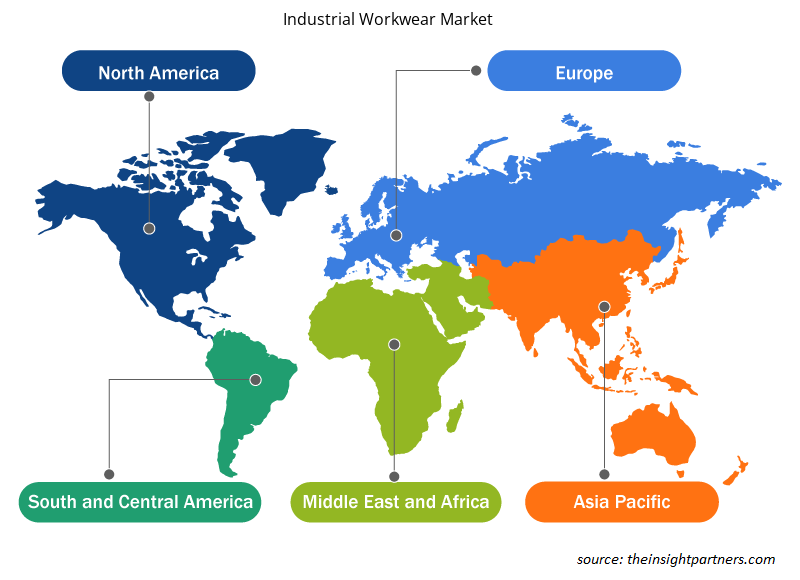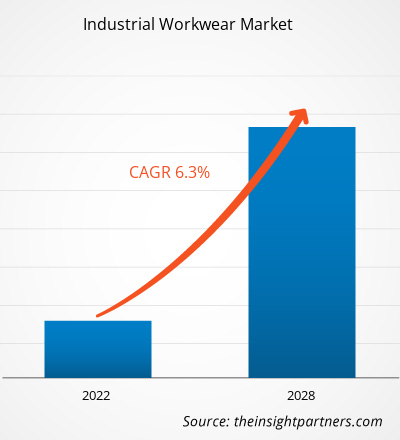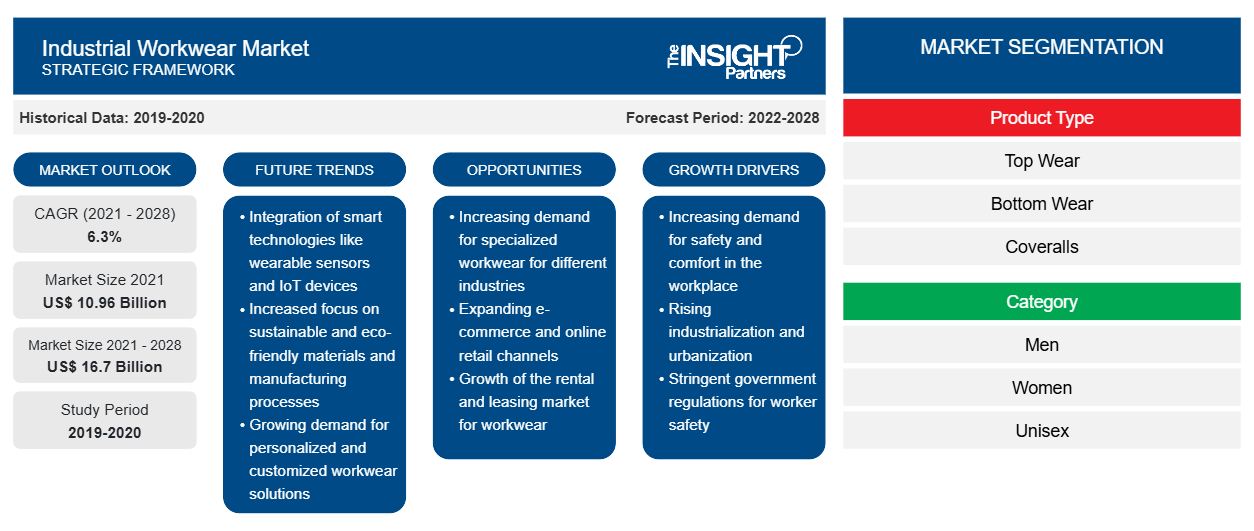Se proyecta que el mercado de ropa de trabajo industrial alcance los 16.697,49 millones de dólares en 2028, frente a los 10.956,69 millones de dólares en 2021. Se espera que crezca a una CAGR del 6,3 % entre 2022 y 2028.
La ropa de trabajo industrial brinda seguridad a los trabajadores y garantiza un entorno de trabajo saludable. La ropa de trabajo se usa ampliamente en varios sectores, incluidos el petróleo y el gas, los productos químicos, la construcción, la fabricación, la automoción, la agricultura y la minería. En los últimos años, las preocupaciones por la seguridad de los trabajadores en los sectores industriales han aumentado rápidamente. Varios gobiernos y asociaciones de seguridad están imponiendo pautas industriales para garantizar la seguridad de los trabajadores, lo que ha aumentado la demanda de ropa de trabajo.
En 2020, América del Norte tuvo la mayor participación del mercado mundial de ropa de trabajo industrial , y se estima que Asia Pacífico registrará la CAGR más alta durante el período de pronóstico. Los países emergentes de Asia-Pacífico, incluidos China e India, están siendo testigos de un aumento en las medidas y los gastos de seguridad laboral, lo que ofrece amplias oportunidades para los actores clave del mercado. Asia Pacífico es un mercado destacado de ropa de trabajo industrial debido al creciente número de accidentes laborales, la mala infraestructura y las iniciativas para reducir las tasas de mortalidad en el lugar de trabajo. Según la Organización Internacional del Trabajo (OIT), informe publicado en 2021, anualmente se registran más de 1,1 millones de muertes en Asia Pacífico debido a accidentes laborales o enfermedades relacionadas con el trabajo. Países como la India tienen la fuerza laboral menos protegida, menos informada y menos capacitada. Las mujeres, los niños, los trabajadores discapacitados, los trabajadores migrantes y las minorías étnicas se encuentran entre la población más afectada y a menudo se ven involucrados en accidentes laborales. Por lo tanto, para reducir los accidentes y lesiones laborales, la construcción, la fabricación, el petróleo y el gas y muchas otras industrias están invirtiendo ampliamente en la seguridad laboral de sus empleados. Por lo tanto, la creciente conciencia sobre la seguridad en el trabajo está impulsando la demanda de ropa de trabajo industrial en Asia-Pacífico.
Personalice este informe según sus necesidades
Obtendrá personalización en cualquier informe, sin cargo, incluidas partes de este informe o análisis a nivel de país, paquete de datos de Excel, así como también grandes ofertas y descuentos para empresas emergentes y universidades.
-
Obtenga las principales tendencias clave del mercado de este informe.Esta muestra GRATUITA incluirá análisis de datos, desde tendencias del mercado hasta estimaciones y pronósticos.
Impacto de la pandemia de COVID-19 en el mercado de ropa de trabajo industrial
La pandemia de COVID-19 y los confinamientos prolongados obstaculizaron la demanda de productos de ropa de trabajo industrial en varios sectores, incluidos el petróleo y el gas, la construcción, la fabricación, la automoción y los productos químicos. La ropa de trabajo industrial se utiliza en varios sectores industriales para garantizar la seguridad de los trabajadores en el lugar de trabajo. Sin embargo, la industria de la ropa de trabajo industrial enfrentó desafíos sin precedentes durante el brote de COVID-19 en 2020. Los fabricantes de ropa de trabajo industrial enfrentaron desafíos importantes debido a las limitaciones de la cadena de suministro causadas por los confinamientos a nivel nacional, las prohibiciones comerciales y las restricciones de viaje. Las interrupciones en las cadenas de suministro crearon una escasez de materias primas, lo que afectó la producción y distribución de varios productos de ropa de trabajo industrial.
En 2021, varias economías e industrias reanudaron sus operaciones a medida que los gobiernos anunciaban la flexibilización de las restricciones impuestas anteriormente. Se permitió a los fabricantes operar a plena capacidad, lo que les ayudó a superar las brechas de demanda y oferta. Así, los fabricantes de ropa de trabajo se centraron en aumentar su producción para reactivar sus negocios.
Perspectivas del mercado
La introducción de estrictas regulaciones gubernamentales impulsa el mercado de ropa de trabajo industrial
La falta de conocimiento sobre la seguridad en el lugar de trabajo y los posibles riesgos para la salud en los lugares de trabajo entre los trabajadores es una preocupación importante en todo el mundo. Para crear conciencia al respecto, muchas organizaciones gubernamentales y no gubernamentales están introduciendo diversos programas y campañas relacionadas con la salud y la seguridad de los trabajadores. Según la Organización Estadounidense de Normalización, en América del Norte, el Departamento de Trabajo y la Administración de Seguridad y Salud Ocupacional (OSHA) de los EE. UU. normalizan el campo de las normas de seguridad y salud ocupacional. Las organizaciones involucradas en el desarrollo de normas para ropa de protección incluyen la Sociedad Estadounidense de Pruebas y Materiales (ASTM), la Asociación Nacional de Protección contra el Fuego (NFPA), el Instituto Nacional de Seguridad y Salud Ocupacional (NIOSH), el Instituto Nacional Estadounidense de Normalización (ANSI), la Asociación Estadounidense de Químicos y Coloristas Textiles (AATCC) y la Asociación de Equipos de Seguridad Industrial (ISEA). Por lo tanto, se espera que la introducción de una regulación gubernamental tan estricta para adoptar ropa de trabajo industrial que garantice la seguridad impulse el crecimiento del mercado.
Información sobre el tipo de producto
Según el tipo de producto, el mercado de ropa de trabajo industrial se segmenta en prendas superiores, inferiores y monos. El segmento de prendas superiores tendría la mayor participación de mercado durante el período de pronóstico. Sin embargo, se espera que el segmento de monos registre la CAGR más alta durante el período de pronóstico. Los monos son prendas simples o dobles que se usan para proteger todo el cuerpo humano en el lugar de trabajo. Estos monos están hechos principalmente de fibras de nailon, algodón y poliamida. Generalmente se utilizan en plantas e industrias de procesamiento químico, como pinturas y recubrimientos y petróleo y gas, debido al alto riesgo de peligros laborales. Protegen a los trabajadores de peligros químicos, mecánicos, térmicos y biológicos. Además, la creciente seguridad y concienciación ocupacional, ayudada por las regulaciones establecidas por los organismos gubernamentales, ha impulsado significativamente la demanda de ropa de trabajo industrial.
Perspectivas de la categoría
Según la categoría, el mercado de ropa de trabajo industrial se segmenta en hombres, mujeres y unisex. El segmento masculino tendría la mayor participación del mercado durante el período de pronóstico, mientras que se proyecta que el segmento unisex registre la CAGR más alta durante el período de pronóstico. Según el informe del Grupo Banco Mundial de junio de 2022, la participación masculina en la fuerza laboral fue del 72% en 2021 en todo el mundo. Como la mayoría de los hombres trabajan en varios sectores industriales y corporativos, la demanda de ropa de trabajo industrial está aumentando. Además, según el informe de la Organización Mundial de la Salud (OMS) del 17 de septiembre de 2021, casi 2 millones de hombres murieron por causas relacionadas con el trabajo. Por lo tanto, para proteger a la fuerza laboral contra lesiones y muertes laborales, los fabricantes se están centrando en nuevas tecnologías, como ropa de trabajo industrial resistente al fuego y aislante. El uso de este tipo de ropa de trabajo ayuda a reducir el número de muertes y lesiones laborales.
Información sobre el uso final
Según el uso final, el mercado de ropa de trabajo industrial se segmenta en petróleo y gas, construcción, productos químicos, automoción, fabricación y otros. El segmento de fabricación representó la mayor participación de mercado en 2020. La principal causa de accidentes industriales en el sector manufacturero es la exposición constante de los trabajadores a un entorno de trabajo peligroso y la falta de disponibilidad de calzado de protección para los trabajadores debido a lo cual se producen lesiones. Los monos, guantes y mangas de protección, gorras/sombreros, abrigos, chaquetas, camisas, calcetines, chaquetas softshell, sudaderas, pantalones, mascarillas, protectores faciales, chalecos y botas y zapatos de protección con puntera protectora están diseñados específicamente para proteger y salvaguardar la parte superior e inferior del cuerpo.
Carhartt, Inc.; ALSICO; A.LAFONT SAS; Honeywell International Inc.; Hultafors Group; Lakeland Inc; Aramark; Ansell Ltd.; VF Corporation; y Mustang Workwear se encuentran entre los principales actores que operan en el mercado de ropa de trabajo industrial. Estas empresas están haciendo hincapié en los lanzamientos de nuevos productos y las expansiones geográficas para satisfacer la creciente demanda de los consumidores en todo el mundo. Tienen una amplia presencia global, lo que les permite atender a un gran conjunto de clientes de todo el mundo y, posteriormente, aumenta su participación de mercado. Estos actores del mercado se centran en gran medida en los lanzamientos de nuevos productos y las expansiones regionales para aumentar su gama de productos en carteras especializadas.
Perspectivas regionales del mercado de ropa de trabajo industrial
Los analistas de Insight Partners explicaron en detalle las tendencias y los factores regionales que influyen en el mercado de ropa de trabajo industrial durante el período de pronóstico. Esta sección también analiza los segmentos y la geografía del mercado de ropa de trabajo industrial en América del Norte, Europa, Asia Pacífico, Oriente Medio y África, y América del Sur y Central.

- Obtenga datos regionales específicos para el mercado de ropa de trabajo industrial
Alcance del informe de mercado de ropa de trabajo industrial
| Atributo del informe | Detalles |
|---|---|
| Tamaño del mercado en 2021 | US$ 10,96 mil millones |
| Tamaño del mercado en 2028 | US$ 16,7 mil millones |
| CAGR global (2021-2028) | 6,3% |
| Datos históricos | 2019-2020 |
| Período de pronóstico | 2022-2028 |
| Segmentos cubiertos |
Por tipo de producto
|
| Regiones y países cubiertos |
América del norte
|
| Líderes del mercado y perfiles de empresas clave |
|
Densidad de actores del mercado de ropa de trabajo industrial: comprensión de su impacto en la dinámica empresarial
El mercado de ropa de trabajo industrial está creciendo rápidamente, impulsado por la creciente demanda de los usuarios finales debido a factores como la evolución de las preferencias de los consumidores, los avances tecnológicos y una mayor conciencia de los beneficios del producto. A medida que aumenta la demanda, las empresas amplían sus ofertas, innovan para satisfacer las necesidades de los consumidores y aprovechan las tendencias emergentes, lo que impulsa aún más el crecimiento del mercado.
La densidad de actores del mercado se refiere a la distribución de las empresas o firmas que operan dentro de un mercado o industria en particular. Indica cuántos competidores (actores del mercado) están presentes en un espacio de mercado determinado en relación con su tamaño o valor total de mercado.
Las principales empresas que operan en el mercado de ropa de trabajo industrial son:
- Tienda de campaña Carhartt, Inc.
- Aramark
- Grupo Alsico
- A. LAFONT SAS
- Honeywell Internacional, Inc.
Descargo de responsabilidad : Las empresas enumeradas anteriormente no están clasificadas en ningún orden particular.

- Obtenga una descripción general de los principales actores clave del mercado de ropa de trabajo industrial
Informe Destacado
- Tendencias progresivas de la industria en el mercado de ropa de trabajo industrial para ayudar a las empresas a desarrollar estrategias efectivas a largo plazo
- Estrategias de crecimiento empresarial adoptadas por los actores del mercado de ropa de trabajo industrial en países desarrollados y en desarrollo
- Análisis cuantitativo del mercado de 2020 a 2028
- Estimación de la demanda mundial de ropa de trabajo
- Análisis de las cinco fuerzas de Porter para ilustrar la eficacia de los compradores y proveedores en el mercado de ropa de trabajo industrial
- Avances recientes para comprender el escenario competitivo del mercado
- Tendencias y perspectivas del mercado, así como factores que impulsan y restringen el crecimiento del mercado de ropa de trabajo industrial
- Asistencia en el proceso de toma de decisiones destacando las estrategias de mercado que sustentan el interés comercial.
- Tamaño del mercado de ropa de trabajo industrial en varios nodos
- Una descripción detallada y dinámica de la industria de ropa de trabajo industrial
- Tamaño del mercado de ropa de trabajo industrial en varias regiones con prometedoras oportunidades de crecimiento
- Análisis histórico (2 años), año base, pronóstico (7 años) con CAGR
- Análisis PEST y FODA
- Tamaño del mercado, valor/volumen: global, regional y nacional
- Industria y panorama competitivo
- Conjunto de datos de Excel
Informes recientes
Informes relacionados
Testimonios
Razón para comprar
- Toma de decisiones informada
- Comprensión de la dinámica del mercado
- Análisis competitivo
- Información sobre clientes
- Pronósticos del mercado
- Mitigación de riesgos
- Planificación estratégica
- Justificación de la inversión
- Identificación de mercados emergentes
- Mejora de las estrategias de marketing
- Impulso de la eficiencia operativa
- Alineación con las tendencias regulatorias























 Obtenga una muestra gratuita para - Mercado de ropa de trabajo industrial
Obtenga una muestra gratuita para - Mercado de ropa de trabajo industrial